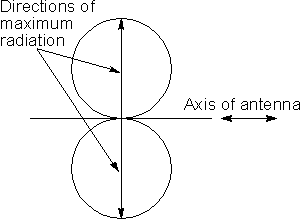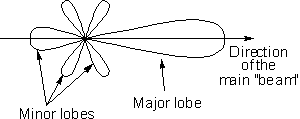Antenna directivity and gain
- an overview, summary, tutorial about the basics of RF antenna directivity
(aerial directivity) and gain including isotropic radiators, polar diagrams and
antenna dBi figures and antenna dBd figures.
RF antennas or aerials do not radiate equally in all
directions. It is found that any realisable RF antenna design will radiate more
in some directions than others. The actual pattern is dependent upon the type of
antenna design, its size, the environment and a variety of other factors. This
directional pattern can be used to ensure that the power radiated is focussed in
the desired directions.
It is normal to refer to the directional patterns and gain in
terms of the transmitted signal. It is often easier to visualise the RF antenna
is terms of its radiated power, however the antenna performs in an exactly
equivalent manner for reception, having identical figures and specifications.
In order to visualise the way in which an antenna radiates a
diagram known as a polar diagram is used. This is normally a two dimensional
plot around an antenna showing the intensity of the radiation at each point for
a particular plane. Normally the scale that is used is logarithmic so that the
differences can be conveniently seen on the plot. Although the radiation pattern
of the antenna varies in three dimensions, it is normal to make a plot in a
particular plane, normally either horizontal or vertical as these are the two
that are most used, and it simplifies the measurements and presentation. An
example for a simple dipole antenna is shown below.

Polar diagram of a half wave dipole in free space
Antenna designs are often categorised by the type of polar
diagram they exhibit. For example an omni-directional antenna design is one
which radiates equally (or approximately equally) in all directions in the plane
of interest. An antenna design that radiates equally in all directions in all
planes is called an isotropic antenna. As already mentioned it is not possible
to produce one of these in reality, but it is useful as a theoretical reference
for some measurements. Other RF antennas exhibit highly directional patterns and
these may be utilised in a number of applications. The Yagi antenna is an
example of a directive antenna and possibly it is most widely used for
television reception.

Polar diagram for a yagi antenna
RF antenna beamwidth
There are a number of key features that can be seen from this
polar diagram. The first is that there is a main beam or lobe and a number of
minor lobes. It is often useful to define the beam-width of an RF antenna. This
is taken to be angle between the two points where the power falls to half its
maximum level, and as a result it is sometimes called the half power beam-width.
Antenna gain
An RF antenna radiates a given amount of power. This is the
power dissipated in the radiation resistance of the RF antenna. An isotropic
radiator will distribute this equally in all directions. For an antenna with a
directional pattern, less power will be radiated in some directions and more in
others. The fact that more power is radiated in given directions implies that it
can be considered to have a gain.
The gain can be defined as a ratio of the signal transmitted
in the "maximum" direction to that of a standard or reference antenna. This may
sometimes be called the "forward gain". The figure that is obtained is then
normally expressed in decibels (dB). In theory the standard antenna could be
almost anything but two types are generally used. The most common type is a
simple dipole as it is easily available and it is the basis of many other types
of antenna. In this case the gain is often expressed as dBd i.e. gain expressed
in decibels over a dipole. However a dipole does not radiated equally in all
directions in all planes and so an isotropic source is sometimes used. In this
case the gain may be specified in dBi i.e. gain in decibels over an isotropic
source. The main drawback with using an isotropic source (antenna dBi) as a
reference is that it is not possible to realise them in practice and so that
figures using it can only be theoretical. However it is possible to relate the
two gains as a dipole has a gain of 2.1 dB over an isotropic source i.e. 2.1 dBi.
In other words, figures expressed as gain over an isotropic source will be 2.1
dB higher than those relative to a dipole. When choosing an antenna and looking
at the gain specifications, be sure to check whether the gain is relative to a
dipole or an isotropic source, i.e. the antenna dBi figure of the antenna dBd
figure.
Apart from the forward gain of an antenna another parameter
which is important is the front to back ratio. This is expressed in decibels and
as the name implies it is the ratio of the maximum signal in the forward
direction to the signal in the opposite direction. This figure is normally
expressed in decibels. It is found that the design of an antenna can be adjusted
to give either maximum forward gain of the optimum front to back ratio as the
two do not normally coincide exactly. For most VHF and UHF operation the design
is normally optimised for the optimum forward gain as this gives the maximum
radiated signal in the required direction.
RF antenna gain / beamwidth balance
It may appear that maximising the gain of an antenna will
optimise its performance in a system. This may not always be the case. By the
very nature of gain and beamwidth, increasing the gain will result in a
reduction in the beamwidth. This will make setting the direction of the antenna
more critical. This may be quite acceptable in many applications, but not in
others. This balance should be considered when designing and setting up a radio
link.
|

